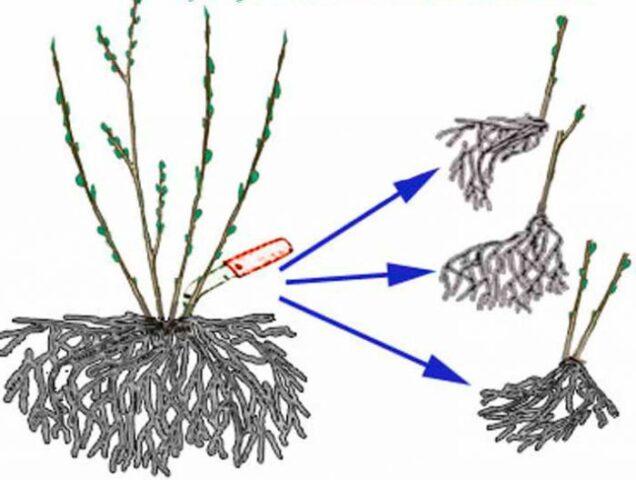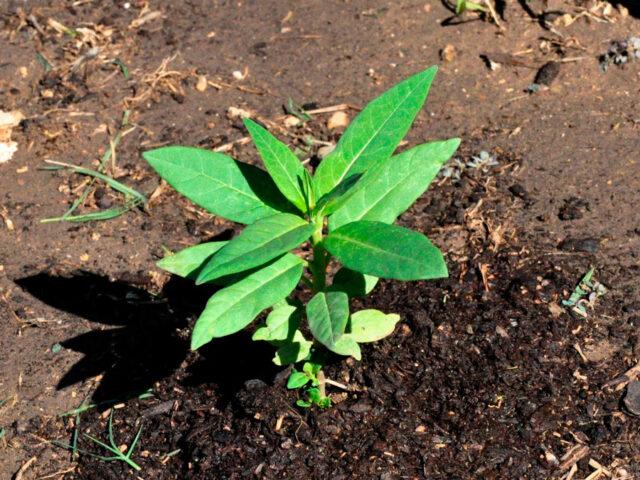Content
- 1 Description of the plant
- 2 Types and varieties
- 3 Cotton wool in landscape design
- 4 Breeding features
- 5 Growing cotton wool from seeds
- 6 Planting and caring for cotton wool in the open field
- 7 Pests and diseases
- 8 Conclusion
The vatnik plant is a short, compact bush with graceful spherical inflorescences. The color is white, yellow, bright orange, red, lilac. Looks beautiful in single plantings and in compositions with other decorative cultures.
Description of the plant
Vatochnik (Asclepias) is a genus of evergreen and deciduous perennial plants from the Apocynaceae family. It also has other names - gusset, asklepias. The latter is associated with the healing properties of certain types of cotton wool (named after the Greek god of healing Aesculapius).
It is a powerful perennial shrub or semi-shrub with strong shoots. Depending on the type, the height can be 1 m or more. The rhizomes of the plant are located horizontally, from the central shoot they diverge over long distances and provide the bush with water and nutrients.
The leaves are large (10–12 cm long), oval or oblong, they are ovoid. They are located opposite or whorled (grow from one point). The color of the upper side of the plate is dark green, the lower one with a grayish tint. The foliage has a pubescence resembling cotton wool. The same layer covers the seeds, which is why the cotton wool got its name.
Asclepias flowers (pictured) begin to appear in July. The process lasts 30–35 days. Inflorescences are racemes of different colors. Medium size: in diameter they reach from 2 to 10 cm.The last buds bloom in September.
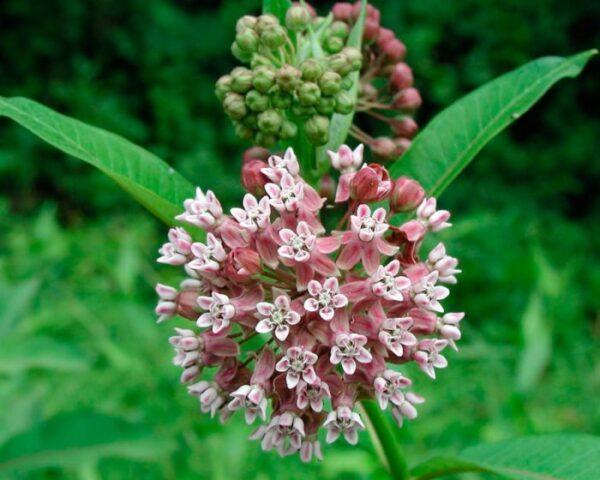
Globular inflorescences of cotton wool on thin pedicels look good anywhere in the garden
Types and varieties
In nature, there are more than twenty species of cotton wool, but most of them are not grown in culture. Only some varieties and varieties are used to decorate the garden.
Asclepias tuberose (Asclepias tuberosa)
Tuberose vatochnik is a low plant, the shoots of which reach 50–70 cm. The inflorescences are large, rich orange, red with yellow tints. Appear in the middle of summer. Rhizomes form tubers, so the species has another name - tuberous wadder.
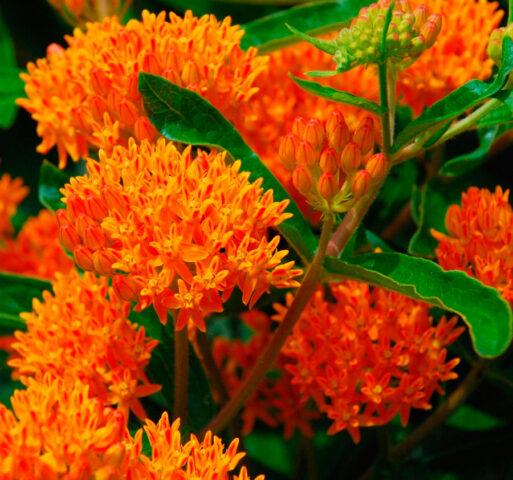
If the autumn is warm, then tuberose wool blooms until the beginning of October.
Most popular varieties: Guy Butterfly, Maharaja.
Guy Butterfly (Asclepias tuberosa gay butterflies)
Tuberose cotton wool Guy Butterfly is one of the best options for decorating a garden. From a mixture of seeds, several varieties can be grown with red, orange, yellow inflorescences.
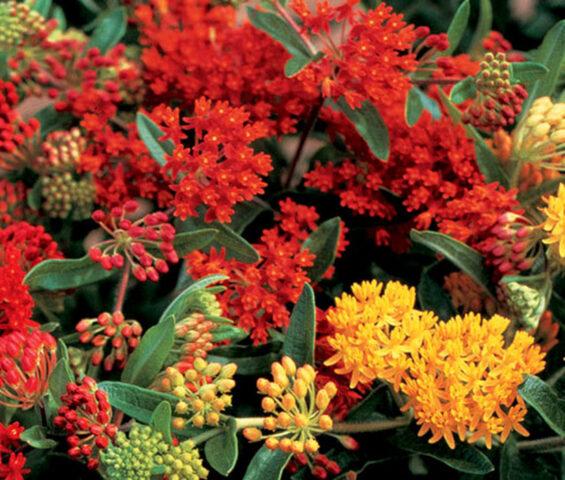
The height of the Guy Butterfly bush is small - up to 70 cm
Maharaja (Asclepias tuberosa Maharaja)
Maharaj's wadder is a compact bush. Its height does not exceed 50 cm.Inflorescences are bright orange umbrellas.

The Maharaja variety is suitable for decorating tracks and for planting in mixborders
Kurasavskiy vatochnik (lastoven) (Asclepias Curassavica)
Kurasavsky (Kurassavsky) vatochnik is also called a lastoven. It is a powerful shrub up to 100 cm high. The plant is evergreen, erect stems, narrow leaves, lanceolate, dark green. In the description of this species of vatnik (pictured), it is indicated that the plant produces orange flowers, collected in umbrella-shaped inflorescences with a diameter of 8-10 cm.
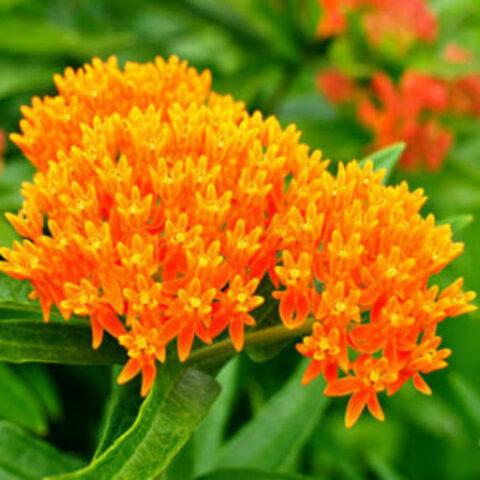
The gingerbread is characterized by a long flowering period: from late spring to early summer
Incarnate vatnik (Asclepias incarnata)
Incarnate vatnik is one of the most beautiful species. Its flowers are rich in red color. Therefore, the plant is also called meat-red wool. Perennial reaches a height of 100-120 cm. It blooms for 30-40 days (in July and August). The leaves are oblong, large, bright green in color. Against their background, red inflorescences look very attractive.
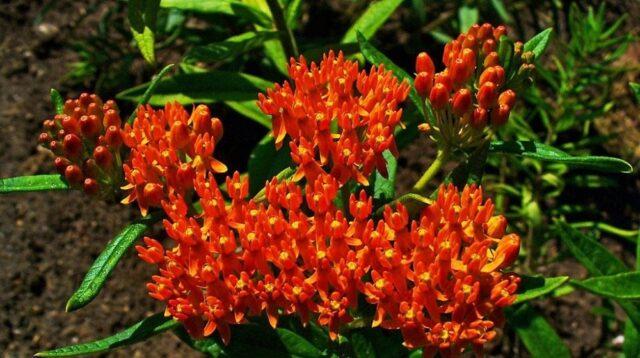
The inflorescences of incarnate willow are rather large, their diameter is 5-6 cm
Cinderella (Asclepias incarnata Cinderella)
Cinderella produces pleasant pink flowers. The stems are thick and strong. Flowering of incarnate vatnik falls on August and early September. The culture prefers open areas, loose and fertile soils.
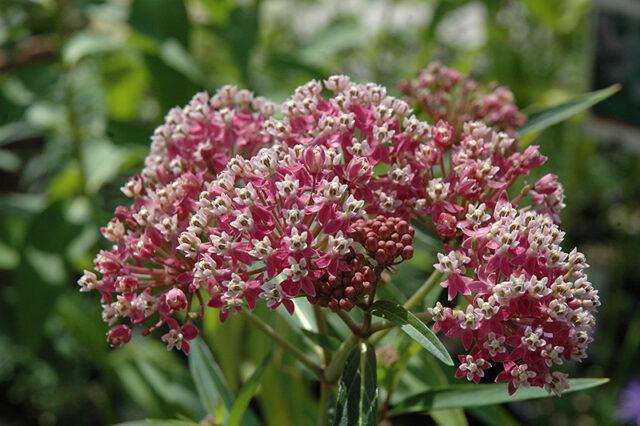
Cinderella bush reaches a height of 100 cm
White Superior (Asclepias incarnata White Superior)
White Superior incarnate variety forms flowers of pure white color, collected in umbrella-shaped inflorescences. Small bush (up to 80 cm). Flowering occurs in the second half of summer. Differs in moderate frost resistance (down to -30 ° C).

In regions with cold winters, the White Superior needs mulching in late autumn
Syrian cotton wool (Asclepias syriaca)
In the description of the Syrian vatnik (pictured), it is indicated that the culture forms pink inflorescences. The shrub reaches a height of 1.5 m. Flowers appear in July. The process takes up to 35 days. If you plant the plant in the shade, then the buds will bloom later, but they will bloom longer.
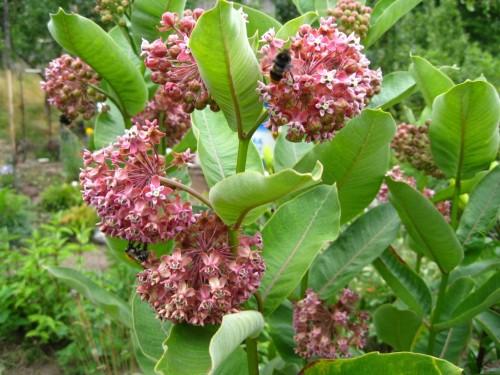
Syrian cotton wool is decorative not only with inflorescences, but also with large light green leaves with reddish veins
If necessary, you can quickly adjust the number of shoots by pruning.
Nice cotton wool (Asclepias Speciosa)
Nice cotton wool is a perennial shrub of small size. Depending on the growing conditions, its height ranges from 30 to 70 cm. The flowers are of an interesting light green color. Inflorescences are spherical. Appears in July and August. The culture is winter-hardy, loves good moisture.

Due to its unusual color, beautiful fleece is often used in cutting.
Sharp Gingerbread (Siberian) (Vincetoxicum sibiricum)
Siberian Lastoven (tsinanchum) is a species of the Kutrov family, found not only in Siberia, but also in the middle zone and in the North Caucasus. The plant belongs to cosmopolitan people - it can be found in Europe, North Africa and some regions of Asia. In shape, it is a perennial herbaceous vine with creeping shoots and triangular leaves. The flowers are white, five-petal, in the form of stars.
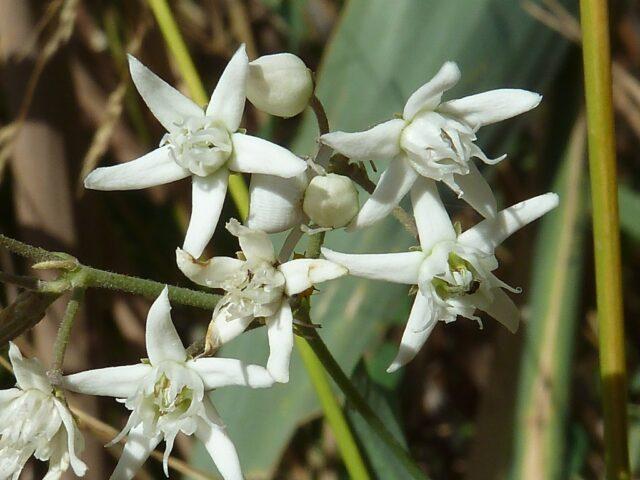
Siberian gullet is decorative thanks to its graceful snow-white flowers
Therefore, children and pets are not allowed on the site. When ingested, the leaves and stems are especially dangerous to dogs.
Cotton wool in landscape design
Vatochnik looks very beautiful both in single plantings and in combination with other ornamental plants: lilac, foxglove, macklea, chubushnik, veronicastrum and others.

Cotton wool can become a decoration of a rocky hill

Asklepias looks good in solo landing

A composition with blooming crops will help to create a bright flower bed.
Breeding features
The plant can be bred in several ways:
- Rhizome division... The roots of all types of cotton wool are very developed, so it is quite easy to divide the bush. Adult plants (over three years old) are dug up and divided into several parts so that each one has several healthy shoots. In a new place, they take root very well. Water and mulch abundantly for the winter. Flowering occurs in the second season after transplanting.
The division of the rhizome is carried out in early spring or early autumn, after the end of flowering
- Cuttings... It is recommended to get the cuttings of the fleece in early summer. To do this, take young shoots up to 15 cm long. All the lower leaves are cut off, and the upper ones are shortened by half. Then they are planted in moistened sand and covered with a jar. They are grown until the end of summer, after which the young seedlings of the fleece can be transferred to a new place.
For the winter, the plant must be mulched.
Growing cotton wool from seeds
It is quite simple to grow cotton wool from seeds. This method will take some time, but it is quite effective.
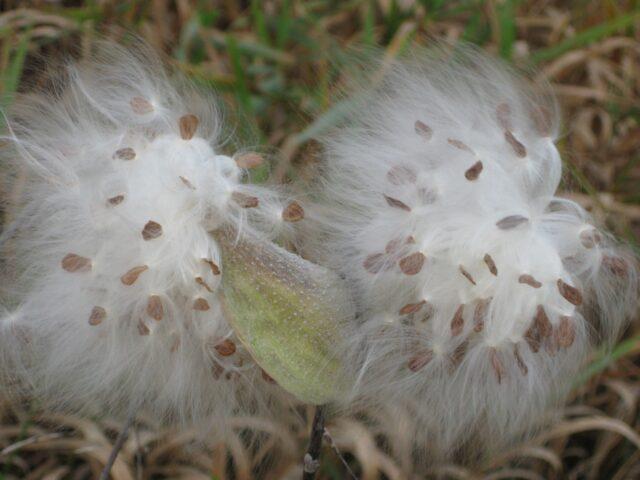
Grains are harvested on their own from ripe fruits or purchased in a store
There is no need to stratify the planting material. It is recommended to immediately determine it in the ground or for seedlings.
When to plant
It is necessary to start growing orange or other species from seeds in the second half of March. Seedlings will appear in 2-3 weeks, and they are transplanted into the ground towards the end of May. At home, the seedlings will grow for about two months.
Preparation of containers and soil
The cotton wool does not need special soil. Therefore, you can purchase an all-purpose flower seedling mix at the store or prepare the soil yourself. To do this, take sod land, humus and peat in a ratio of 2: 1: 1.
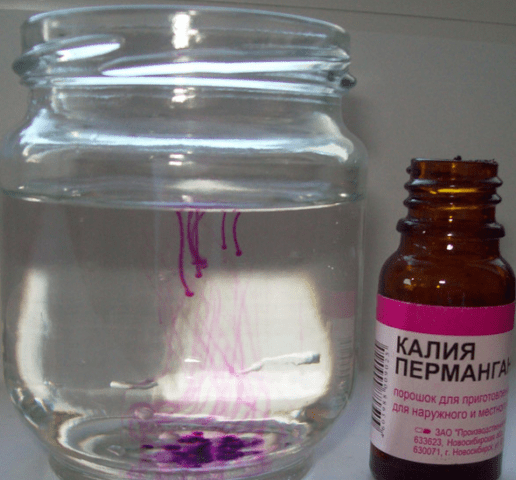
The soil is disinfected in a solution of potassium permanganate (1%) or put in the freezer for several days
In the process of growing seedlings, diving is used. Therefore, initially the seeds are planted in common containers. These can be wooden boxes, plastic containers, or cassettes. Previously they can be doused with boiling water or washed with a weak solution of potassium permanganate.
Planting cotton wool seeds
The seeds of the fleece are buried by 1–1.5 cm (when planted in open ground - up to 3 cm). Several furrows are pre-made at a distance of 3-5 cm. After planting, the containers are placed in a cool place. The temperature should be no more than +18 ° C. The surface is covered with a foil with holes. With a lack of light, additional illumination is organized (up to a total of 10 hours per day).
Care for seedlings of cotton wool
In order to get a beautiful and healthy plant, when growing cotton wool from seeds, special attention should be paid to caring for the seedlings. The culture is unpretentious, so the germination rate of even old seeds is more than 90%.
Vatochnik requires only regular watering with warm, settled water. As soon as the seedlings grow 3-4 cm, the film must be removed. A few days after this, the seedlings dive into separate containers. At the same time, pinch the top to activate the growth of lateral shoots. The place is shaded. Two weeks before transplanting into the ground, plants can be periodically taken out to the balcony or outside for hardening.
Planting and caring for cotton wool in the open field
Most species and varieties of cotton wool are quite winter-hardy, so planting and caring for them in the climatic conditions of the Moscow region will not be difficult. To get a flowering plant, it is enough to adhere to some rules.
Recommended timing
Planting time depends on the breeding method. Grown up seedlings of cottonwood are planted in the second half of May, when there is no longer any frost. Rhizomes take root well when planted in October (in the south - in November). The cuttings are transferred to a permanent place at the end of summer, watered regularly, and mulched for the winter.
Site selection and soil preparation
Vatochnik loves sunny, open areas.But light partial shade up to four hours a day is also acceptable. Therefore, the culture can be placed near shrubs or medium-sized trees. The soil for the plant should be neutral or slightly acidic, preferably light, fertile loam. If the soil is poor or has a heavy structure, it must be prepared in advance (in the fall). The site is cleaned and dug up. Apply 3-5 kg of humus or 30-40 g of mineral fertilizer per 1 m2. If the soil is clay, then add 500-800 g of sawdust or coarse sand.
Landing algorithm
Planting cotton wool is easy. Since the bush is not very sprawling, it is enough to leave an interval of 50–70 cm between neighboring plants. Planting instructions:
- Dig holes of small diameter.
Recommended pit size - 50x50 cm
- Lay out a drainage layer 5-7 cm.
Pebbles, broken brick, expanded clay are used as drainage material.
- Seedlings are rooted, covered with fertile soil.
The earth in the hole is gently pressed with your hands
- Water and mulch abundantly.
Peat, humus, sawdust, straw, wood chips are used as mulch.
Watering and feeding schedule
To grow a beautiful fleece with attractive flowers, as shown in the photo, after planting, it is important to follow the basic rules of care and create optimal conditions. One of the main ones is regular watering.
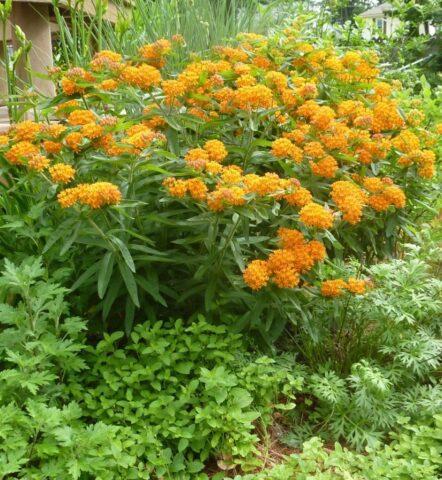
Vatochnik - a culture that loves hydration
Water is given every week, especially in the first month after planting. Adult bushes do not need abundant watering, since the rhizomes grow well and extract moisture from the soil.
Plants are fed in early spring. To do this, you can use a complex mineral fertilizer (for example, azofoska) or organic matter (compost, rotted manure, urea).
Weeding and loosening
It is recommended to loosen the soil periodically, especially after watering and heavy rains. Thanks to this, the roots of the plant will freely receive oxygen and nutrients. Weeding is carried out as needed. To drown out the growth of weeds, the soil around the wadder is mulched with straw, hay, peat, humus.
Leaving during flowering
During flowering, plants periodically remove wilted peduncles. This stimulates the growth of new inflorescences. The cut points are sprinkled with charcoal or ash powder. To promote bud formation, the plant can be fed with superphosphate and potassium salt in the same ratio.
Wintering
In regions with cold winters, the culture is cut at the beginning of October, leaving hemp 1 cm high. After that, the plant is insulated with foliage, sawdust, spruce branches are laid (if available). This layer is removed in early spring.
Pests and diseases
The plant has good immunity. But sometimes it can be affected by whiteflies and spider mites. When pests appear, the crop is sprayed with insecticides: Aktara, Fufanon, Aktellik, Decis.
Conclusion
The fleece plant is distinguished by its unpretentiousness and winter hardiness. The bush is decorative thanks to the lush flowers that appear within 30-40 days or more. The variety of species allows you to choose from different colors - from snow-white to rich red.
